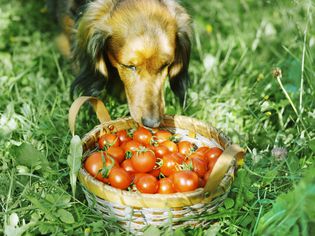Can dogs eat plums? Pet parents who would like to share the occasional fruit with their dog may find themselves asking this question. The answer is yes, dogs can eat plums, but proper precautions need to be taken to prevent serious and potentially life-threatening consequences.
Find out how you can safely share plums with your dog.
Can Dogs Eat Plums?
Yes, dogs can eat plums, but only if the stems, leaves, and pits have been removed. Plum stems, leaves, and pits are considered toxic, and these toxic components can cause cyanide poisoning in dogs. However, the flesh and skin are generally considered safe.
If you intend to feed your dog plums, it’s best to do so as the occasional treat rather than as a regular part of your dog’s diet. Keep in mind that treats, including fruits such as plums, should not make up more than 10% of your dog’s caloric intake. The remaining 90% of their calories need to come from their well-balanced dog food.
A couple of slices of a prune, which is a dried plumb, can be safe for most healthy dog. However, the same components that need to be removed from a plumb need to be removed from a prune.
You should always check with your dog’s veterinarian before you feed a new food, especially if your dog has a chronic health condition like food allergies or diabetes.
Potential Risks and Concerns
There are several significant risks to consider if you’re going to feed your dog plums.
- Cyanide poisoning: The stems, leaves, and pits of plums can cause cyanide poisoning. Even chewing on a pit can result in poisoning. Signs of cyanide poisoning include brick red gums, dilated pupils, panting, difficulty breathing, collapse, and shock.
- Intestinal blockage: Plum pits can become stuck in the stomach or intestines, leading to gastrointestinal obstruction and vomiting. In some cases, surgery may be required to resolve the issue.
- Choking: Due to their shape and size, plum pits are a choking hazard.
- High sugar levels: The high amount of sugar in fruits like plums can contribute to obesity and may not be safe for dogs with health issues like diabetes.
After feeding plum to your dog, it’s best to monitor them for any reactions, such as excessive drooling, vomiting, tremors, or loss of appetite. If your dog has any signs of illness after eating a plum, contact your veterinarian.
Health Benefits of Plums for Dogs
Plums can provide a good source of fiber that will help your dog have healthy bowel movements. Plums also contain ivitamin A, vitamin C, and potassium. This fruit also contains a lot of antioxidants that may help reduce inflammation in the body.
If your dog is eating a well-balanced diet that’s been approved by the Association of American Feed Control and if that food is making up at least 90% of their daily calories, then they are meeting all of their daily nutritional needs with or without plums.
Alternatives to Plums
While plums can be safe when properly prepared, there are other fruits that may make safer treats for your dog. Make sure to discuss any new foods with your veterinarian before giving them to your dog.
- Bananas
- Strawberries
- Apples
- Blueberries
- Oranges
- Pumpkin
While your dog can eat plums, there are significant dangers if certain components of the fruit aren’t removed. Make sure you understand how to ensure a plum is safe for your dog. Otherwise, it may be best to select a different fruit to give as the occasional treat.








